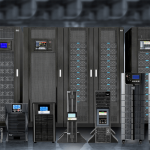At first glance, specifying an uninterruptible power supply seems a complex task. But in essence, whether you’re buying a new UPS system or replacing an existing unit, the choice boils down to two main factors: required load and battery autonomy.
To establish the required power consumption, separate out the critical loads (that will need protecting by the UPS) from the non-critical. In a call centre, for example, telephones and computers would be classified as critical, but desk fans not. For a factory, production lines and machinery are critical, but non-essential lighting or telephone lines not so much.
Establishing the load requirement will determine which UPS topology is best-suited (standby/offline, line-interactive, or online).
The second main criteria is battery autonomy. How much runtime do you need to carry out a safe shutdown? When you’re thinking about runtime, you should also consider how much space you have to install batteries.
Other Factors Influencing Your Choice Of UPS
- Installation environment: do you need a freestanding tower (typically for industrial sites) or rack-mounted (usually with IT loads) UPS? And where will the UPS be fitted? UPS systems work best in dry, dust-free, well-ventilated rooms with a consistent and controlled temperature. If the UPS is rear rather than front-venting, you’ll need to leave a 300mm gap.
- Installation configuration: do you need to build in redundancy, such as an N+1 parallel system, to mitigate against the risk of serious system failure?
- UPS maintenance: does the UPS have front panel access for maintenance or does it require side access? If it’s the latter, it has implications for configuring the system.
- Warranties: the industry norm for UPS systems is a two or perhaps three year warranty. Zektron UPS offers a 3-year extended warranty as standard on all UPS up to and including 3 kVA.
- Accessories: It’s recommended to always incorporate a bypass switch. Depending on your networking and communications requirements, SNMP cards or other BMS connections might be advisable.
- Features: does the UPS include an LCD or even touchscreen display panel that gives you important performance information? What operating modes does it have (i.e. ECO mode, Smart Active, Frequency Converter)?




